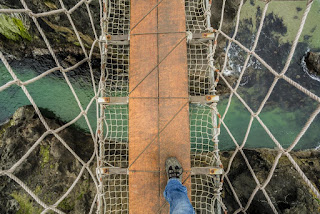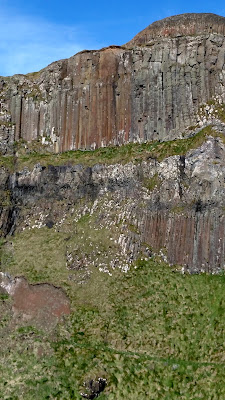I wrote this post on the plane coming back from Ireland last month to replace the quicky post I put up while there. But what the heck, I'll leave that one up too. This post goes into the details of the places we saw on Day 2. I have updated the publish date to be the date we did all this.
Our hotel in Drogheda offered a big delicious “full Irish” breakfast, which I gather means with meat and eggs. Of course I had to try the mysterious sounding black pudding, which was very flavorful, especially before I found out it was made with cow blood. I skipped the white pudding, made with intestines.
DRIVING FAST PAST BELFAST
Our plan for the day was to drive the big freeway, or motorway as they call them here, to Belfast, have lunch, then explore the northern side of Northern Ireland's coast, and finally beeline for our first bed and breakfast SW of Derry. An ambitious day. Luckily, I was feeling no jet lag, so behind the wheel I climbed, on the right hand side of the manual transmission car!
Belfast was too soon for our full bellies, so we blasted on through. My only impression of Belfast is: only 3 exits? I thought it would be much bigger. I wish we could have stopped for a coffee or something, but adventure was calling so we motored on.
We lunched in Bally-blah-blah. Every other town (or as they say here, every second one) is named Bally-something-or-other, which is the English translation “village of…” from Gaelic.
Carrick-a-rede
Someone had said the Carrick-a-rede swinging rope bridge was cool, so that's where we headed. They were right!
A 1 km hike on a nice path along the gorgeous sea cliffs
with views to Rathlin Island and all the way clear to Scotland (the land to the right of island with dark top and white cliffs at the water line in the picture above) because we are visiting in the new global-warming-induced dry season,
with views to Rathlin Island and all the way clear to Scotland (the land to the right of island with dark top and white cliffs at the water line in the picture above) because we are visiting in the new global-warming-induced dry season,
leads to a gated bridge with attendants on each side. (I imagine this
is the place delinquent high school kids try to sneak out to after
hours.)
The bridge walk, contrary to what the guidebook says, is not very scary; I've been on way worse. But it is wonderfully high and has smashing waves and darting sea birds below.
 |
| not my picture |
 |
| not my picture but gives you an idea of the height |
The reason for the installation of the bridge in the first place is not, as it seems today, to extract dollars from tourists, but rather for fishermen to access the salmon fishing grounds from this little island.
In addition to fishing in the immediate vicinity of the little island, historically, black diabase (they call it dolerite) was mined just above the entrance to the car park and shipped from this point to Scotland and the rest of northern Europe. Diabase is a volcanic rock, part of the roots of the volcano whose flows created the resistant rock that forms the little island. According to the knowledgeable and good humored attendant to the car park, this stone was extremely popular as cobblestones and building stones in northern Europe during the Victorian age.
The attendant gave us more geologically important information: the remains of the concrete and stone buildings on the coast below us were part of a cement manufacturing operation. The limestone for the cement came from continental crust, not the much younger volcanic rock.
That was a very worthwhile stop!
GIANTS CAUSEWAY
A few 10s of km down the road was the day's main attraction: Giant's Causeway.
So yeah, we have friends to visit in this country, and
yeah, the country is beautiful, and yeah, it's where some of my
ancestors were born, but I will admit, Giants Causeway was a
significant reason I wanted to visit Ireland. I mean, columnar jointing
as the main attraction for a national park? That means they’ve got
their priorities straight, and also just screams “Lucy must see!!”
I
was not disappointed, and I'll go out on a ledge (pun!) here and say my
travel companions were not either. The Giants Causeway is truly
spectacular, especially on a glorious sunny day.Columnar jointing forms in basalt lava flows as they cool and contract.
The North Channel between Ireland and Scotland has eroded the thick basalt flows and left a peninsula of spectacular columns to play on.There is a matching exposure of columnar jointing in Scotland called Fingals Cave. (next trip?)
Drew and I did the a little longer hike out to where the trail was closed due to landslide activity while Jim and Shelly headed onward to check into our B&B.
I loved this part of the hike almost as much as the causeway. Cool giant basalt columns, hydrothermal alteration patterns, chilled flow margins, and more spectacular coastline.
I should mention the forklore behind the name Giants Causeway. Something about a giant on a causeway. I guess I'm more into the science.
I lingered on the columns as long as I could before we hit the road past very stinky field applications of manure to the B&B.
I lingered on the columns as long as I could before we hit the road past very stinky field applications of manure to the B&B.
After checking in, we met Jim and Shelly at The Fishermans Inn, the one and only local pub in Carrigans, for the best fish and chips I've ever had, no joke! Jim liked the mushy peas, too.
The fish was mild and the batter was salty and flavorful. A Smithwicks or two to round out the meal put the end to busy and beautiful day.



























No comments:
Post a Comment